The Sliding Triangle
If you read the Reuleaux
Triangle lesson, you may have wondered about the curves traced by the
centroid and vertices of the Reuleaux as it rotated within the rhombus.
Essentially, what we had was a rigid figure with two of its points sliding
along intersecting lines. I want to examine the locus of a third point on
the figure.
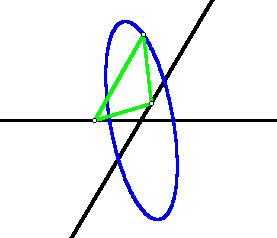 It was
easy enough to model the configuration on Sketchpad. Since we are interested
in only three points of the figure, substitute a triangle and have two
of the vertices attached to intersecting lines. When I move the triangle
along the lines, the trace of the third vertex appears to be an ellipse,
but that has not been proved.
It was
easy enough to model the configuration on Sketchpad. Since we are interested
in only three points of the figure, substitute a triangle and have two
of the vertices attached to intersecting lines. When I move the triangle
along the lines, the trace of the third vertex appears to be an ellipse,
but that has not been proved.
To understand this problem, it might be helpful to review the definitions
of the ellipse. It has several equivalent definitions:
An ellipse is a conic section, the intersection of a right circular
cone and a plane which is parallel to none of its generators.
An ellipse is the set of all points in the plane, whose undirected distances
from a fixed focus are in constant ratio e to their distances from
a fixed line (directrix), where 0 < e
< 1. The parameter e is called the eccentricity.
An ellipse is the locus of all points in the plane, the sum of whose
distances from two fixed foci is constant.
An ellipse in standard position, with semi-major axis a and semi-minor
axis b, may be defined as the set of all points satisfying this
equation:

That same ellipse may be defined by these parametric equations:
x = acosθ, y = bsinθ
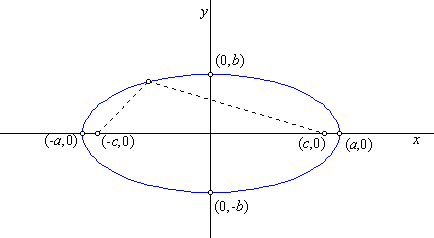
That last definition, with the parametric equations, is the one I want
to use. Here is a corresponding sketch. The coordinates of the foci use
the constant c, defined by this equation: c2 = a2
- b2. It may also be defined in terms of the eccentricity,
e. c = ae.
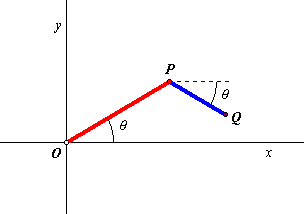 Now click this image to open a Java applet. You will see the construction shown
in this sketch. Drag point P in a circle around the origin and watch the
trace of point Q. The red segment has length (a + b)/2.
The length of the blue segment is (a - b)/2. Using this information,
you should be able to compute the coordinates of point Q in terms
of θ. Do this and verify that its coordinates
match those of the parametric equation for an ellipse. Try changing the
lengths of the segments, and see how it affects the ellipse.
Now click this image to open a Java applet. You will see the construction shown
in this sketch. Drag point P in a circle around the origin and watch the
trace of point Q. The red segment has length (a + b)/2.
The length of the blue segment is (a - b)/2. Using this information,
you should be able to compute the coordinates of point Q in terms
of θ. Do this and verify that its coordinates
match those of the parametric equation for an ellipse. Try changing the
lengths of the segments, and see how it affects the ellipse.
Notice that the directions of OP and PQ change at the
same rate, but in opposite rotation directions. Also notice that the lengths
of the segments do not matter. That is, we never did say what a
and b were. We can choose arbitrary segment lengths and use them
to define a and b. From this we can make a general statement.
Given a point P tracing a circle about some fixed center O,
if point Q revolves about P at the same rate, but opposite
direction, and if OP and PQ have constant lengths, then Q
must trace an ellipse.
I skipped a few steps there, so maybe you can fill in the gaps. Since
OP and PQ are rotating in opposite directions, they must
be parallel for some orientation, but not necessarily on the x and y axes,
as in the example above. In fact, there is no reason that O has to be
the origin. If you start with any points O, P, and Q,
you should be able to just set them in motion. Point P orbits O, and Q orbits P, like a star, a planet, and a moon. If they have the same orbital period, but opposite direction, then point Q will trace an ellipse. Try it.
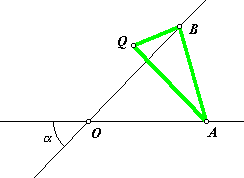 So how
does this fit in with the triangle that is tethered to the two intersecting
lines? Click this image to open another applet. Play around
with it first. See how the ellipse changes as you change intersection angle α, or as you change the shape of the triangle. What happens when you form
an isosceles triangle? How can you make it trace a circle? Or a line segment?
So how
does this fit in with the triangle that is tethered to the two intersecting
lines? Click this image to open another applet. Play around
with it first. See how the ellipse changes as you change intersection angle α, or as you change the shape of the triangle. What happens when you form
an isosceles triangle? How can you make it trace a circle? Or a line segment?
In this applet, triangle ABQ may move freely as long as points
A and B stay on their respective lines, which are fixed with
angle α. Do you see any points
traveling in a circular path? Neither do I. But try looking at it another
way. We can construct a circle through points A, B, and O.
Label the center P. While the circle moves, the inscribed angle
BOA is constant, α. Therefore, the interior
angle BPA is constant, 2α. That interior
angle subtends a constant chord, AB, therefore the circle has constant
radius.
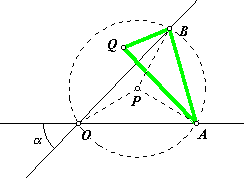 You should
be able to see several important relationships in this picture. Distance
OP is constant, so P travels in a circle about O.
PA and PB are constant, so that fixes P with respect to segment
AB, and hence, with respect to the triangle. Therefore, PQ has constant
length. If it can be shown that OP and PQ rotate in opposite
directions at the same rate, then that will show that Q traces an
ellipse. That part is left as an exercise.
You should
be able to see several important relationships in this picture. Distance
OP is constant, so P travels in a circle about O.
PA and PB are constant, so that fixes P with respect to segment
AB, and hence, with respect to the triangle. Therefore, PQ has constant
length. If it can be shown that OP and PQ rotate in opposite
directions at the same rate, then that will show that Q traces an
ellipse. That part is left as an exercise.
Here are some other things to think about. Many of the answers may be
found (without explanation) by showing the hidden work in the Sketchpad file below.
What are the angles PAB and PBA?
How can you construct the parameters a, b, and c?
What about the orientations of the semi-major and semi-minor axes?
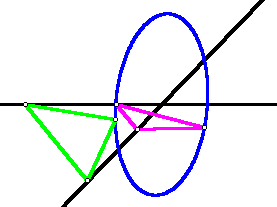 I discovered
that each of these triangles has what I call a ghost, a different triangle
which may be attached to the same pair of lines to generate the same ellipse.
Do you see how the ghost is constructed? Hint: in the first applet,
see what happens when you use the same segment lengths but in a different
order.
I discovered
that each of these triangles has what I call a ghost, a different triangle
which may be attached to the same pair of lines to generate the same ellipse.
Do you see how the ghost is constructed? Hint: in the first applet,
see what happens when you use the same segment lengths but in a different
order.
Since this all started with the Reuleaux triangle, maybe we should bring
it back to that. In the section where I wrote about the trace of the centroid,
I said that it did not trace an ellipse. That was correct. As the reuleaux triangle
rotates in a rhombus, the centroid follows four distinct curves. Each is
a part of an ellipse. The changes occur because the vertices slide on different
sides of the rhombus. If the acute angle of the rhombus is lest than 60°,
then two of the curves will be circular arcs.
Geometer’s Sketchpad Files
The Java applets presented here were created with the Geometer’s Sketchpad. The corresponding Sketchpad files may be downloaded here.
Back to Whistler Alley Mathematics
Last update: August 3, 2011 ... Paul Kunkel whistling@whistleralley.com
For email to reach me, the word geometry must appear in the body of the message.